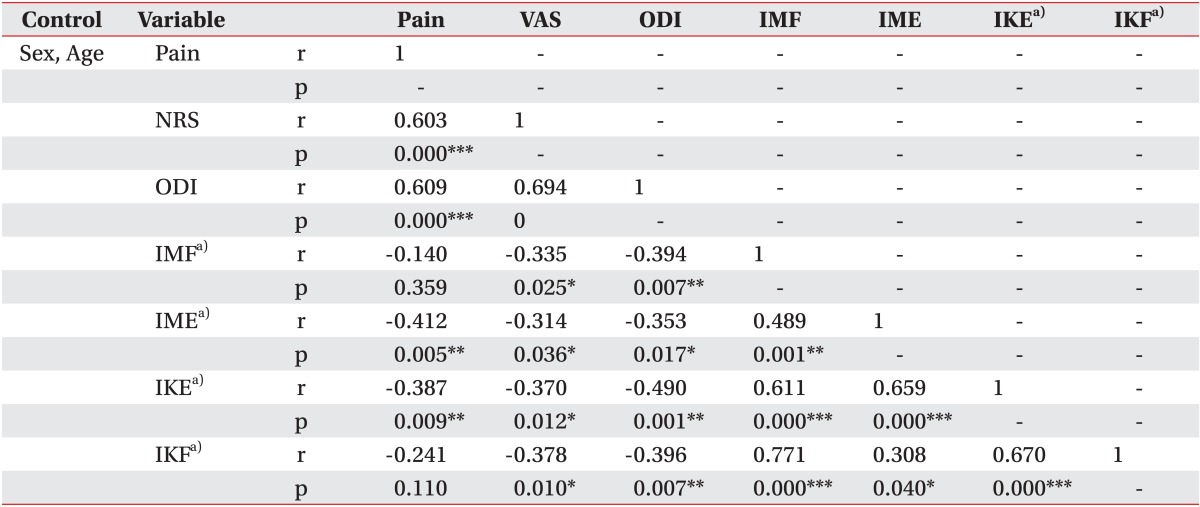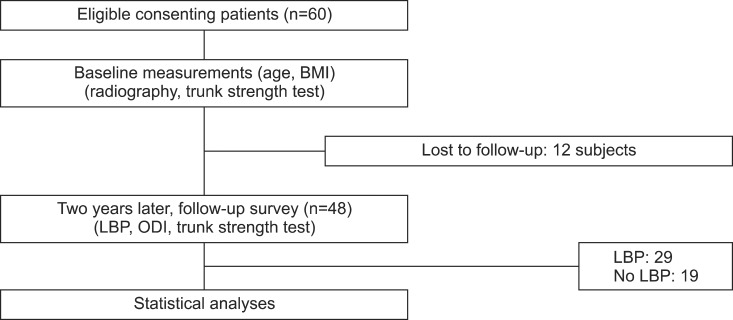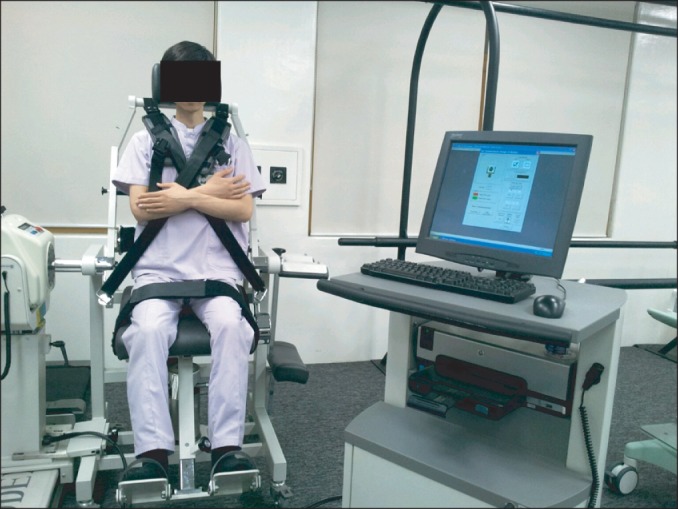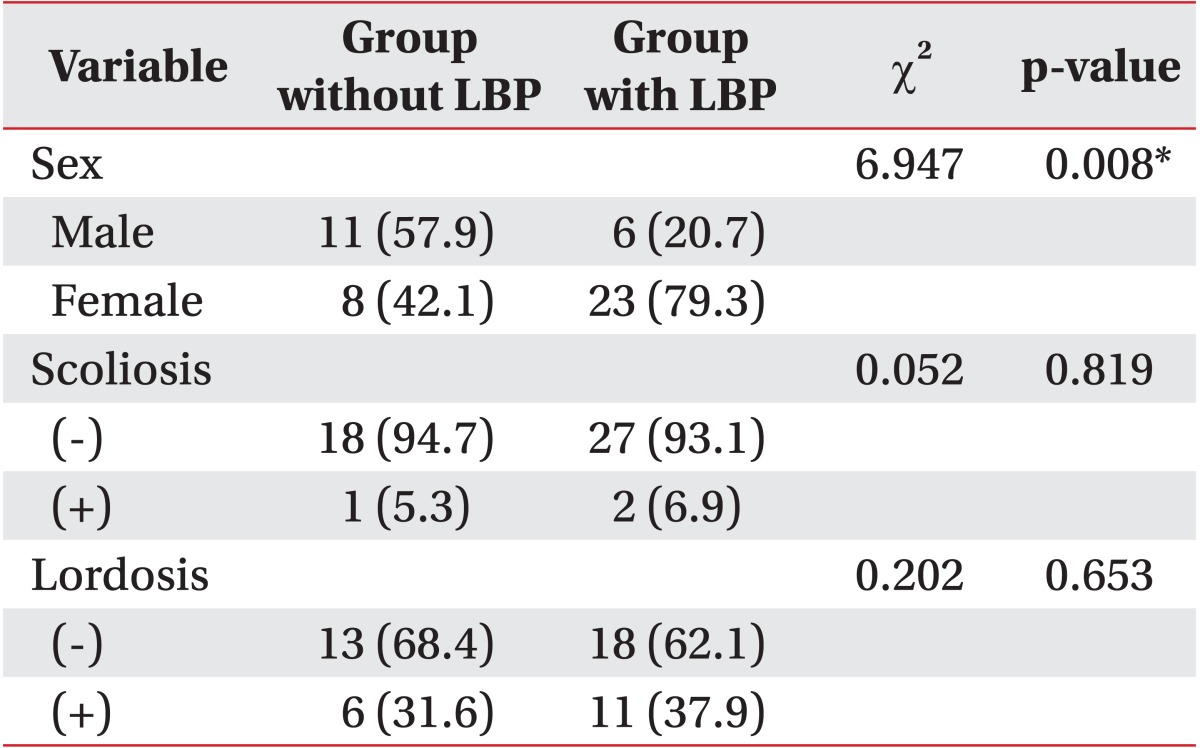1. Walsh K, Cruddas M, Coggon D. Low back pain in eight areas of Britain. J Epidemiol Community Health. 1992; 46:227–230. PMID:
1386619.

2. Pengel LH, Herbert RD, Maher CG, Refshauge KM. Acute low back pain: systematic review of its prognosis. BMJ. 2003; 327:323. PMID:
12907487.

3. Andersson GB. Epidemiological features of chronic low-back pain. Lancet. 1999; 354:581–585. PMID:
10470716.

4. van den Hoogen HJ, Koes BW, van Eijk JT, Bouter LM, Deville W. On the course of low back pain in general practice: a one year follow up study. Ann Rheum Dis. 1998; 57:13–19. PMID:
9536816.

5. Linton SJ, van Tulder MW. Preventive interventions for back and neck pain problems: what is the evidence? Spine (Phila Pa 1976). 2001; 26:778–787. PMID:
11295900.
6. Park YJ, Choi KS, Lee SG. Effect of lumbar extensor strengthening in chronic low back pain patients. J Korean Acad Rehabil Med. 2000; 24:295–300.
7. Kim KY. Clinico-radiologic findings of the whole spine in patients with chronic low back pain. J Korean Acad Rehabil Med. 2000; 24:137–145.
8. Vaz G, Roussouly P, Berthonnaud E, Dimnet J. Sagittal morphology and equilibrium of pelvis and spine. Eur Spine J. 2002; 11:80–87. PMID:
11931071.

9. Jeon CH, Kim DJ, Kim SK, Kim DJ, Lee HM, Park HJ. Validation in the cross-cultural adaptation of the Korean version of the Oswestry Disability Index. J Korean Med Sci. 2006; 21:1092–1097. PMID:
17179693.

10. George SZ, Childs JD, Teyhen DS, Wu SS, Wright AC, Dugan JL, et al. Predictors of occurrence and severity of first time low back pain episodes: findings from a military inception cohort. PLoS One. 2012; 7:e30597. PMID:
22355317.

11. Bejia I, Younes M, Jamila HB, Khalfallah T, Ben Salem K, Touzi M, et al. Prevalence and factors associated to low back pain among hospital staff. Joint Bone Spine. 2005; 72:254–259. PMID:
15850998.

12. Evans K, Refshauge KM, Adams R, Aliprandi L. Predictors of low back pain in young elite golfers: a preliminary study. Phys Ther Sport. 2005; 6:122–130.

13. Burdorf A, Jansen JP. Predicting the long term course of low back pain and its consequences for sickness absence and associated work disability. Occup Environ Med. 2006; 63:522–529. PMID:
16849528.

14. Chon J, Kim SW, Kim SS, Kim YG, Choi HJ, Ahn KH, et al. Risk factors of low back pain in a general population. J Korean Acad Rehabil Med. 2000; 24:981–987.
15. Egger GJ, Vogels N, Westerterp KR. Estimating historical changes in physical activity levels. Med J Aust. 2001; 175:635–636. PMID:
11837872.

16. Nachemson A. The load on lumbar disks in different positions of the body. Clin Orthop Relat Res. 1966; 45:107–122. PMID:
5937361.

17. Hedman TP, Fernie GR. Mechanical response of the lumbar spine to seated postural loads. Spine (Phila Pa 1976). 1997; 22:734–743. PMID:
9106313.

18. Pope MH, Goh KL, Magnusson ML. Spine ergonomics. Annu Rev Biomed Eng. 2002; 4:49–68. PMID:
12117750.

19. Liuke M, Solovieva S, Lamminen A, Luoma K, Leino-Arjas P, Luukkonen R, et al. Disc degeneration of the lumbar spine in relation to overweight. Int J Obes (Lond). 2005; 29:903–908. PMID:
15917859.

20. Leboeuf-Yde C. Body weight and low back pain: a systematic literature review of 56 journal articles reporting on 65 epidemiologic studies. Spine (Phila Pa 1976). 2000; 25:226–237. PMID:
10685488.
21. Jackson RP, Simmons EH, Stripinis D. Incidence and severity of back pain in adult idiopathic scoliosis. Spine (Phila Pa 1976). 1983; 8:749–756. PMID:
6229884.

22. Gremeaux V, Casillas JM, Fabbro-Peray P, Pelissier J, Herisson C, Perennou D. Analysis of low back pain in adults with scoliosis. Spine (Phila Pa 1976). 2008; 33:402–405. PMID:
18277872.

23. Alaranta H, Luoto S, Heliovaara M, Hurri H. Static back endurance and the risk of low-back pain. Clin Biomech (Bristol, Avon). 1995; 10:323–324.
24. Han TR, Kim JH, Chung SG, Kwon BS, Lee KW. Correlation of ultrasonographic measure of lumbar multifidus muscles with isometric torque of low back. J Korean Acad Rehabil Med. 1999; 23:809–814.
25. Brukner P, Khan K. Clinical sports medicine. 3rd rev. ed. Sydney: McGraw-Hill;2010.
26. Bigos SJ, Holland J, Holland C, Webster JS, Battie M, Malmgren JA. High-quality controlled trials on preventing episodes of back problems: systematic literature review in working-age adults. Spine J. 2009; 9:147–168. PMID:
19185272.

27. Hides JA, Jull GA, Richardson CA. Long-term effects of specific stabilizing exercises for first-episode low back pain. Spine (Phila Pa 1976). 2001; 26:E243–E248. PMID:
11389408.

28. Barr KP, Griggs M, Cadby T. Lumbar stabilization: a review of core concepts and current literature, part 2. Am J Phys Med Rehabil. 2007; 86:72–80. PMID:
17304690.
29. Hestbaek L, Leboeuf-Yde C, Kyvik KO. Are lifestyle-factors in adolescence predictors for adult low back pain? A cross-sectional and prospective study of young twins. BMC Musculoskelet Disord. 2006; 7:27. PMID:
16539729.







 PDF
PDF ePub
ePub Citation
Citation Print
Print





 XML Download
XML Download